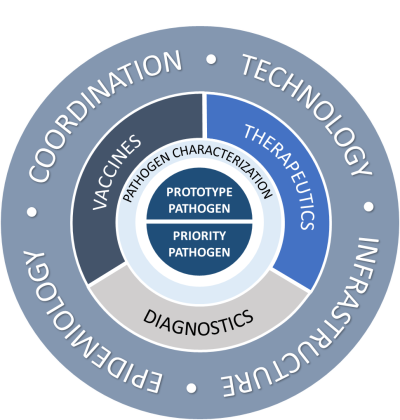Preemptive Approach Designed to Identify Viral Threats Before they Emerge
February 2, 2022

NIAID’s approach to pandemic preparedness
As the global COVID-19 pandemic continues into its third year, the National Institute of Allergy and Infectious Diseases (NIAID), part of the National Institutes of Health, is focusing on preparing for a range of other viral threats that could cause a public health emergency. For decades, NIAID has launched major research responses and developed medical countermeasures to combat multiple emerging infectious diseases, including HIV/AIDS, SARS-CoV-1, Middle East respiratory syndrome coronavirus (MERS-CoV), Ebola virus, Zika virus, and SARS-CoV-2.
According to NIAID’s new Pandemic Preparedness Plan, the institute will direct its preparedness efforts on two fronts. First, researchers will identify “prototype pathogens”—viruses within viral families with the potential to cause significant human disease. Knowledge gained from studying prototype pathogens will also build a framework for a rapid research and product development response for other viruses within that virus family should an outbreak occur. For example, NIAID’s earlier research on SARS-CoV-1 and MERS-CoV informed rapid vaccine development for SARS-CoV-2 in 2020. The plan’s second key research focus is on priority pathogens—viruses already known to be capable of causing significant human illness or death, such as Zika virus.
NIAID aims to support critical basic and preclinical studies to characterize these prototype and priority pathogens, including understanding viral biology and structure, host-immune responses, mechanisms of immune evasion, disease pathogenesis and animal models of disease. NIAID will apply this knowledge to conduct translational and clinical research to develop diagnostics; therapeutics, including antivirals, monoclonal antibodies, and broad-spectrum approaches; and vaccines. These efforts are designed to shorten timelines between pathogen emergence and authorization/approval of candidate products.
The institute’s comprehensive preparedness efforts will also include novel epidemiology and pathogen discovery programs, pre-clinical and clinical infrastructure capacity, technology enhancements to hasten therapeutic and vaccine development, and a robust and coordinated communication structure, according to the plan. NIAID will continue to collaborate with partners in the U.S. and foreign governments, the biopharmaceutical industry, and international organizations on its preparedness efforts.
The new plan was informed by a November 2021 workshop NIAID hosted to facilitate discussions with the scientific community about the development of a pandemic preparedness strategy and prioritizing prototype pathogens within viral families of concern. Moving forward, NIAID will continue to engage the scientific community and U.S. and global partners to ensure preparedness planning efforts are collaborative, integrated, and aligned with current scientific research.
WHAT:
NIAID Pandemic Preparedness Plan
WHO:
NIAID Director Anthony S. Fauci, M.D., is available to speak about the new NIAID plan.
Contact
Submit a Media Request
Contact the NIAID News & Science Writing Branch.

